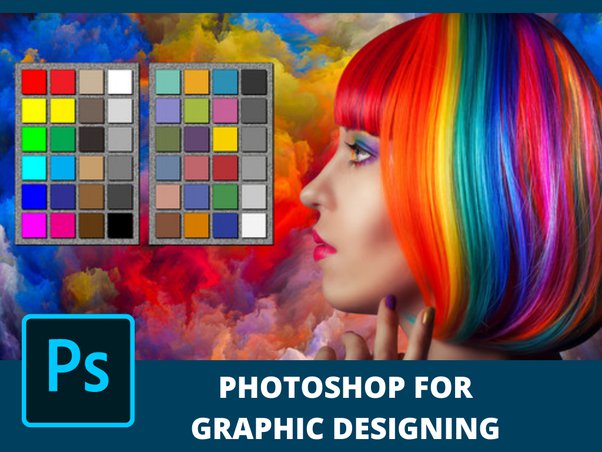Are you aware that 90% of professional graphic designers use Adobe Photoshop for their projects? While Photoshop is undeniably a powerful tool, it’s essential to consider if it alone is adequate for all your graphic design needs. As you navigate the realm of design software, ponder the question: Is Photoshop truly enough for graphic design, or are there other programs that may better suit your creative endeavors?
Pros and Cons of Using Photoshop
When considering the pros and cons of using Photoshop for graphic design, it is essential to understand the tool’s capabilities and limitations in various design scenarios. Graphic manipulation is one of Photoshop’s strong suits, allowing you to enhance and transform images with precision. The software offers unparalleled design flexibility, enabling you to create a wide range of digital illustrations, web graphics, and layouts. Image editing in Photoshop is seamless, whether you are making simple color corrections or engaging in complex manipulations. Moreover, Photoshop encourages creative experimentation, pushing the boundaries of your design projects. It serves as a professional tool for designers, offering a vast array of features tailored to meet industry standards. While Photoshop may not always be the best choice for every design task, its versatility for various graphic design purposes makes it a go-to tool for many professionals seeking to elevate their creative projects.
Alternatives to Photoshop for Design
Exploring alternative graphic design software options beyond Photoshop can significantly enhance your creative capabilities and cater to varying design preferences and project needs. When considering design software comparison, there are creative alternatives like Adobe Illustrator, CorelDRAW, Affinity Designer, and Canva that offer unique features to meet your digital design solutions. Adobe Illustrator focuses on vector-based images, making it ideal for precise shapes and logo design. CorelDRAW provides a user-friendly interface with extensive tools for various design projects. Affinity Designer stands out as a cost-effective alternative combining Illustrator and Photoshop functionalities, suitable for both print and digital design. Canva, an online platform, offers pre-designed templates and customization options for visually appealing designs, especially for social media graphics and presentations. Each of these graphic design tools presents distinct design software features, providing a plethora of options to explore for your creative projects.
Photoshop Vs. Illustrator for Design
Comparing Photoshop and Illustrator for design reveals distinct strengths and applications that cater to different aspects of graphic design.
Key Points:
- Design software comparison: Photoshop is raster-based, ideal for photo editing, while Illustrator focuses on vectors, perfect for precise shapes and logos.
- Creative tool selection: Choose based on project needs; Photoshop for photo manipulation and web graphics, Illustrator for scalable designs and typography.
- Graphic design preferences: Preference varies; Photoshop suits those working with images, while Illustrator caters to those needing scalable graphics.
When deciding between Photoshop and Illustrator, consider your design program suitability based on the project requirements. If you need to work with photographs and create web graphics, Photoshop is the go-to choice. On the other hand, if you require precise shapes, scalable designs, and typography, Illustrator would be more suitable. Your visual creation choices will be influenced by the unique strengths of each software in enhancing your design projects.
Photoshop for Web Design
In web design, utilizing Photoshop as a primary tool offers designers a robust platform for creating visually engaging layouts and graphics. When designing for the web, key elements like responsive layouts, image optimization, web graphics, layer management, and design consistency are crucial. Photoshop provides features for creating responsive designs by allowing designers to work with different file formats and manage layers effectively. Image optimization tools in Photoshop help in maintaining web performance by reducing file sizes without compromising quality. Designers can craft visually appealing web graphics using Photoshop’s extensive design capabilities. Additionally, layer management in Photoshop enables designers to organize elements efficiently, ensuring design consistency throughout the web layout. By leveraging Photoshop for web design, you can create compelling and functional websites that resonate with users across various devices, emphasizing the importance of responsive design and visual aesthetics in the digital landscape.
Photoshop for Print Design
When delving into the realm of print design, Photoshop emerges as a powerful ally for crafting visually striking and professional print materials. Here’s why Photoshop is indispensable for print design:
- Enhanced Print Quality: Photoshop allows for high-resolution editing, ensuring that your printed materials come out crisp and clear.
- Precise Color Correction: With its advanced color correction tools, Photoshop enables you to achieve accurate color reproduction for your prints.
- Creative Layout Design: Utilize Photoshop’s layout design features to arrange your elements effectively and create visually appealing print designs.
Moreover, Photoshop offers extensive capabilities for applying various typography effects and conducting intricate image manipulations to elevate the overall quality of your printed materials. By harnessing the power of Photoshop in print design, you can achieve professional results that meet the highest standards of quality and creativity.
Photoshop for Digital Illustration
Harness the advanced tools and capabilities of Photoshop to elevate your digital illustrations to a professional level of quality and creativity. When delving into digital illustration, mastering key techniques is vital. Utilize digital painting techniques to bring your creations to life, experiment with layer blending modes for depth and texture, and employ color theory applications to evoke emotions in your audience. Enhance your illustrations further by exploring brush customization tips to achieve unique textures and effects. Additionally, consider creating custom brushes tailored to your specific style and needs. To help visualize the importance of these techniques, here’s a table showcasing their impact:
| Technique | Importance | Effectiveness |
|---|---|---|
| Digital Painting | Express creativity | High impact on style |
| Layer Blending Modes | Depth and texture | Enhances visual appeal |
| Brush Customization | Unique effects | Personalizes artwork |
Photoshop for Photo Editing
Transitioning from digital illustration to photo editing within Photoshop unlocks a new realm of creative possibilities and technical precision for graphic designers seeking to enhance and manipulate images with finesse. When delving into photo editing with Photoshop, you will find yourself immersed in a world of endless potential. Here are three key aspects that make Photoshop a powerhouse for photo editing:
- Photo retouching: Photoshop provides a plethora of tools for refining and perfecting images, allowing you to seamlessly eliminate imperfections and enhance the overall quality of your photos.
- Image manipulation: With Photoshop’s advanced features, you can manipulate images in ways that defy reality, transforming ordinary photos into extraordinary works of art through creative editing techniques.
- Color correction, graphic enhancements, and creative filters: Whether adjusting colors to achieve the perfect tone, adding graphic elements to enhance visual impact, or applying creative filters for unique effects, Photoshop equips you with the tools needed to elevate your photos to new heights of creativity and professionalism.
Enhancing Creativity With Photoshop
To elevate your graphic design projects to new levels of creativity and professionalism, utilizing Photoshop opens up a realm of endless possibilities for enhancing your artistic vision. Creative inspiration can blossom as you delve into the myriad tools that Photoshop offers. Through artistic experimentation, you can push the boundaries of traditional design and infuse your work with innovative elements. Design innovation becomes second nature as you navigate the software’s features to bring your visions to life. Visual storytelling takes on new dimensions as you master the art of combining images, text, and graphics in captivating ways. Digital manipulation allows you to transform raw concepts into polished masterpieces, giving you the power to mold and shape your designs with precision. Embrace Photoshop as more than just a tool; let it be the catalyst for unleashing your creativity and turning your ideas into impactful visuals that resonate with your audience.




